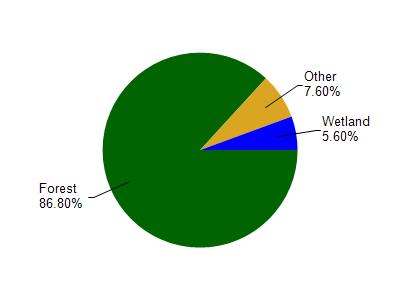Bayfield
Yes
Yes
No
Fish and Aquatic Life
Overview
This small feeder stream to Pikes Creek begins in springs and wetlands, and the stream's most significant tributary drains Sultz Swamp (see discussion of Sultz Swamp under Resources of Concern in the Bayfield Peninsula West (LS06)). The entire creek is considered a Class I trout fishery and outstanding resource water. Many of the resident fish are the offspring of lake run trout and salmon. A muck and clay bottom is found near the headwaters of North Pikes Creek, with rubble and various-sized boulders becoming more common downstream. Most of the bank cover is a mixture of alder, hazel and hardwoods, and a variety of conifers. Some stretches of the stream have had a history of damage caused by streambank pasturing and animal waste runoff. Other activities in the watershed include orchards, gravel pits and some forestry.
Date 1999
Author Aquatic Biologist
Condition
Wisconsin has over 84,000 miles of streams, 15,000 lakes and milllions of acres of wetlands. Assessing the condition of this vast amount of water is challenging. The state's water monitoring program uses a media-based, cross-program approach to analyze water condition. An updated monitoring strategy (2015-2020) is now available. Compliance with Clean Water Act fishable, swimmable standards are located in the Executive Summary of Water Condition in 2018. See also the 'monitoring and projects' tab.
Reports
Management Goals
Wisconsin's Water Quality Standards provide qualitative and quantitative goals for waters that are protective of Fishable, Swimmable conditions [Learn more]. Waters that do not meet water quality standards are considered impaired and restoration actions are planned and carried out until the water is once again fishable and swimmable
Management goals can include creation or implementation of a Total Maximum Daily Load analysis, a Nine Key Element Plan, or other restoration work, education and outreach and more. If specific recommendations exist for this water, they will be displayed below online.
Monitoring
Monitoring the condition of a river, stream, or lake includes gathering physical, chemical, biological, and habitat data. Comprehensive studies often gather all these parameters in great detail, while lighter assessment events will involve sampling physical, chemical and biological data such as macroinvertebrates. Aquatic macroinvertebrates and fish communities integrate watershed or catchment condition, providing great insight into overall ecosystem health. Chemical and habitat parameters tell researchers more about human induced problems including contaminated runoff, point source dischargers, or habitat issues that foster or limit the potential of aquatic communities to thrive in a given area. Wisconsin's Water Monitoring Strategy was recenty updated.
Grants and Management Projects
| Project Name (Click for Details) | Year Started |
|---|
|
|
Monitoring Projects
| WBIC | Official Waterbody Name | Station ID | Station Name | Earliest Fieldwork Date | Latest Fieldwork Date | View Station | View Data |
|---|
| 2885100 | North Pikes Creek | 10034876 | North Pikes Creek downstream of powerline Station #1 | 1/1/2015 | 10/6/2020 | Map | Data |
| 2885100 | North Pikes Creek | 10013526 | North Pikes Creek- 15 Meters Upstream Star Route Road-Station #1 | 1/1/2015 | 1/1/2015 | Map | Data |
|

Watershed Characteristics
North Pikes Creek is located in the Bayfield Peninsula Southeast watershed which is 301.48 mi². Land use in the watershed is primarily forest (86.80%), wetland (5.60%) and a mix of grassland (4.10%) and other uses (3.50%). This watershed has 453.79 stream miles, 291,749.17 lake acres and 6,560.31 wetland acres.
Nonpoint Source Characteristics
This watershed is ranked Not Ranked for runoff impacts on streams, Not Available for runoff impacts on lakes and Low for runoff impacts on groundwater and therefore has an overall rank of Low. This value can be used in ranking the watershed or individual waterbodies for grant funding under state and county programs.However, all waters are affected by diffuse pollutant sources regardless of initial water quality. Applications for specific runoff projects under state or county grant programs may be pursued. For more information, go to surface water program grants.